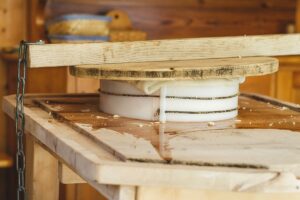María Villagrasa & Nuria García
Having access to grass, especially at night, is an important element when considering dairy cow well-being. However, access to grass is not always possible, either because of its scarcity, particularly as the size of the farm increases, or because of its unavailability, for example, at times of the year when the soil is wet.
An alternative that has increasingly sparked interest among producers because of both animal well-being and performance are external courtyards with the soil covered with soft materials such as sand or saw dust (bedded outdoor pack), where cows can move and lie more naturally than in a free stall barn.
Some of the advantages of this type of accommodations are the reduction of leg injuries, the improvement of cow comfort and the increased heat detection, production and longevity.
Given the absence of land or grass in these areas, external courtyards can generally be used year-round and require less space than grass, although little is known about what the right surface area is. In order to learn more about this aspect, research conducted at the University of British Columbia (Canada) studied whether the available space affected cows’ preference for being in the outer courtyard and their behavior (displacement from the lying position and time spent lying down).
Free access to the outdoor pack
Three groups of 24 pregnant Holstein cows were used. Each group underwent a five-day adaptation phase where they had free access to an outdoor patio of 384 m2 (16 m2/cow) of gravel covered with about 20 cm of sand, and on top, about 20 cm of saw dust. Cows were taken outside (if they had not left yet) at set times each day during this phase; then given free access to the outdoor patio, but the size of the available surface was changed every day. A total of 13 different space allocations were randomly applied, from 4 to 16 m2/cow in 1 m2 increments.
More time in the outdoor pack at night
The most relevant finding was that cows spent more time outdoors as available space increased over 24 hours; this result however, influenced more the time spent overnight than during the day, probably because the temperature and humidity rate is higher during the day and cows tend to protect themselves from high temperatures.
The increase in space available had no influence on changing lying to standing postures. In addition, the time cows spent lying outside was not affected by space available.
There were also no differences in the length of time cows spent lying outside overnight because of the space available. One possible explanation for this is that cows might have preferred to stay out since the soil was softer than that available inside, regardless of the space available.
Conclusions
The main findings of this study were as follows:
- As the available space increased, cows housed in free stalls preferred to spend more time in an outdoor courtyard at night but not during the day.
- At night the space available outside did not influence the number of displacements from the lying posture or the total time the cows spent lying down.
Given the partial preference of dairy cows for an external yard, the authors believe that this should be considered when designing dairy farming systems in places where grass is not accessible.
Reference
Smid, A. M. C., Weary, D. M., von Keyserlingk, M. A. G. Effect of outdoor open pack space allowance on the behavior of freestall-housed dairy cows. 2020. J. Dairy Sci. 103:3422–3430.
© 2020 Dairy Research Review. All Rights Reserved.











